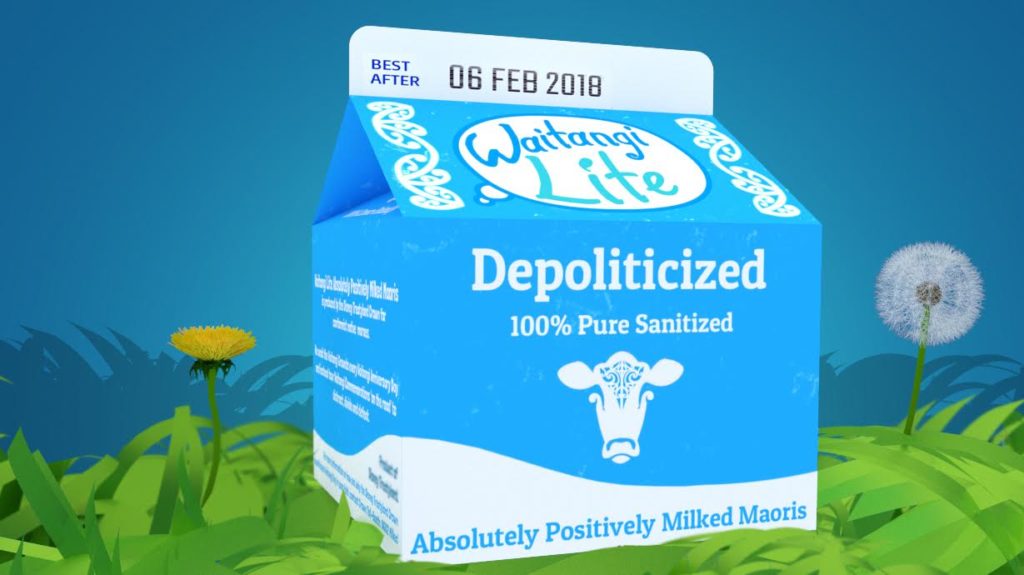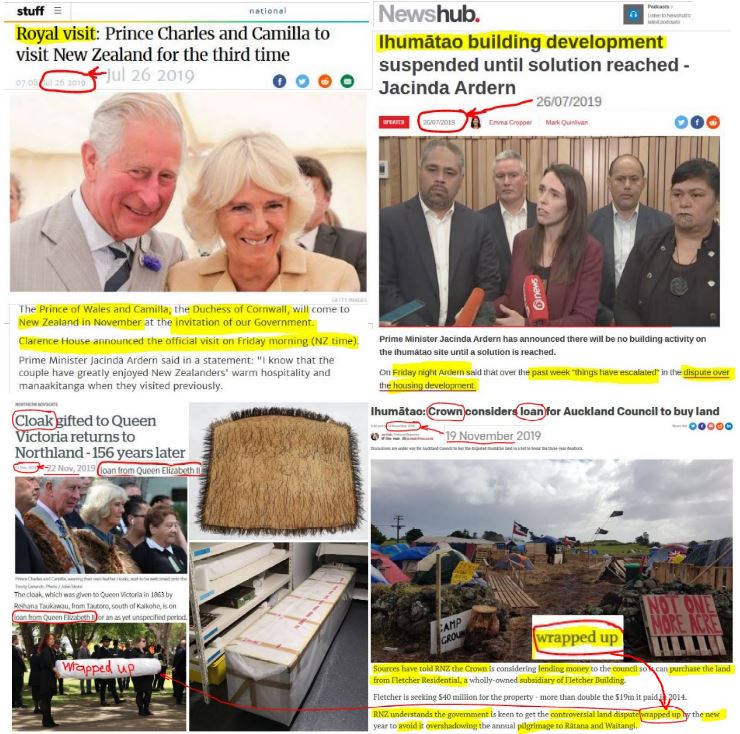
The Snoopman
QEII Korowai Loan Cues Tax Herd-Funded Ihumātao Land Buy-Back Loan?
At Waitangi on 20 November 2019, Prince Charles appeared to signpost the solution in the dispute at Ihumātao over land confiscated by the Crown in July 1863, with the symbolic loan of the korowai gifted to Queen Victoria by Chief Reihana Takauwau on July 15th 1863.
At the centre of the land dispute at Ihumātao, in Mangere, near Auckland International Airport, is the delicate issue of whether any public and private institutions will stump-up the money so that the community of Ihumātao — whom are seeking the return of ancestral lands — can prevent the historically significant site from being bulldozed for a housing development. The $19 million land sale of March 20 2016 between the settler Wallace Family and transnational-bank owned Fletcher Building Limited, required two Crown Ministers to waiver a breach to the Overseas Investment Act 2005. The Act specifies that farm land must be advertised for sale on the open market in the 12 month period prior to sale to an overseas buyer. The developer, Fletcher Building Limited, is 54% owned by three transnational banks: HSBC, JP Morgan Chase and CitiBank.
With the presentation of the ‘wrapped up’ korowai at Waitangi, the Neo-Feudal Prince seemed to signal that a tax-herd funded buy-back of the disputed land on the Ihumātao Peninsula via a Crown loan to Auckland Council – might do the trick.
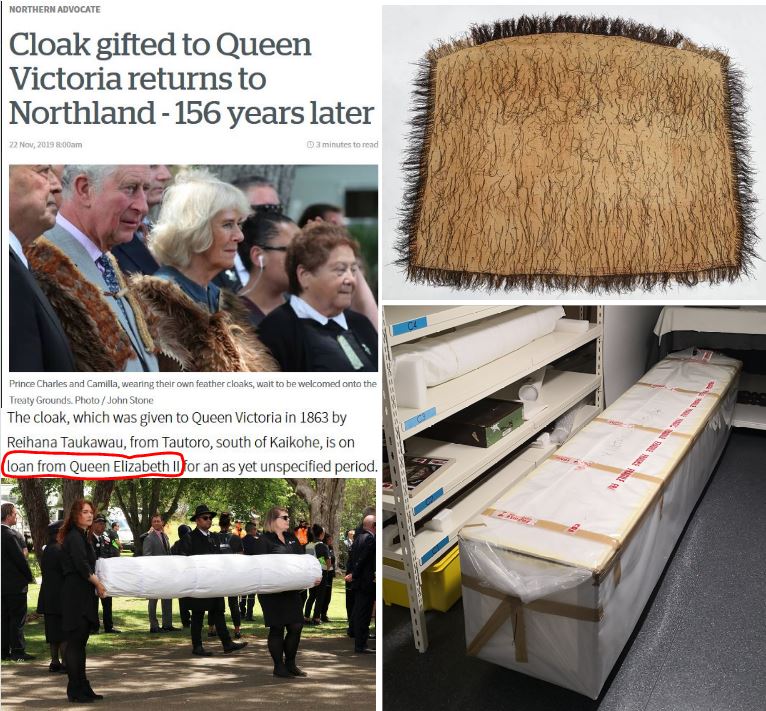
Magically, a ‘leak’ occurred during the Royal Tour week, with Radio New Zealand reporting the idea of a Crown loan to buy-out Fletcher Building Limited’s stake in the land at Ihumātao. This leak appeared to be a strategically-timed Test the Waters Ritual. RNZ reported it believed “the government is keen to get the controversial land dispute wrapped up by the new year to avoid it overshadowing the annual pilgrimage to Rātana and Waitangi” [Emphasis added].
However, the phenomenon of the coinciding loan events is consistent with game theory where players make moves, post bonds, and communicate tacit threats and promises to construct political or social stability.
In game theory, ‘posting a hostage’ is the mechanism to construct stability and is predicated on a provisional promise to cooperate if other players post hostages too. In their paper, “Resolving social conflicts through hostage posting: theoretical and empirical considerations,” Gideon Keren and Werner Raub noted that “tacit communications of threats and promises are two major message strategies used to influence the behaviours of others”. Therefore, ‘the game’ requires an implied threat, which signals a defection on the next move if the other player does not post a hostage too, as their paper in the Journal of Experimental Psychology explained.
Therefore, it would appear that when the Neo-Feudal Duke of Cornwall said at Waitangi – “I humbly reaffirm my commitment and that of my children and my grandchildren to this bond between us” – he was signposting the bond of the korowai on loan to signal he had been put up a hostage to advance the Crown Monopoly Game to protect a Sole Sovereign Player: The Monarch and all Her Heirs.
Because, if the Crown lost control of the crisis narrative, the crisis rituals, and the crisis solutions, then the land dispute at Ihumātao could quickly snowball into an exquisite crisis of governance. Especially, if a critical mass of Māori changed the political ground around the Government by effectively demanding the return of lands vested with Māori sovereign title – in election year, 2020.
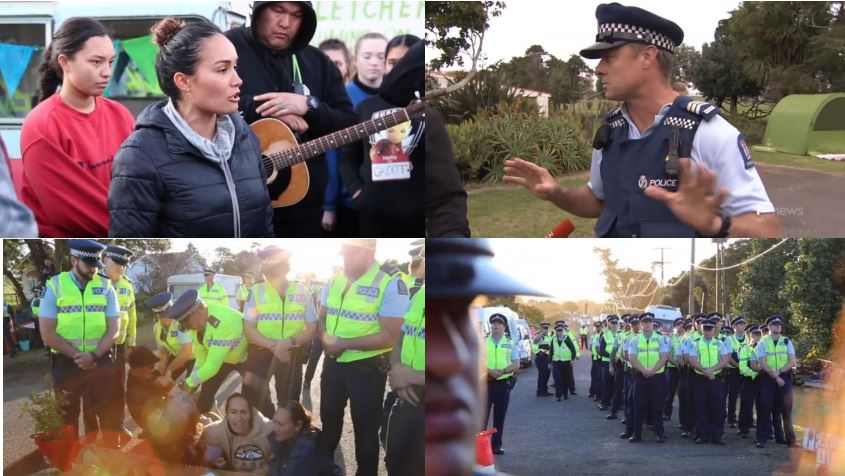
Particularly, because the Royal Tour was first announced on the morning of Friday 26th July, which was the same day that NZ Prime Minister Jacinda Ardern and her Māori Labour Caucus back-peddled over the Ihumātao land dispute.
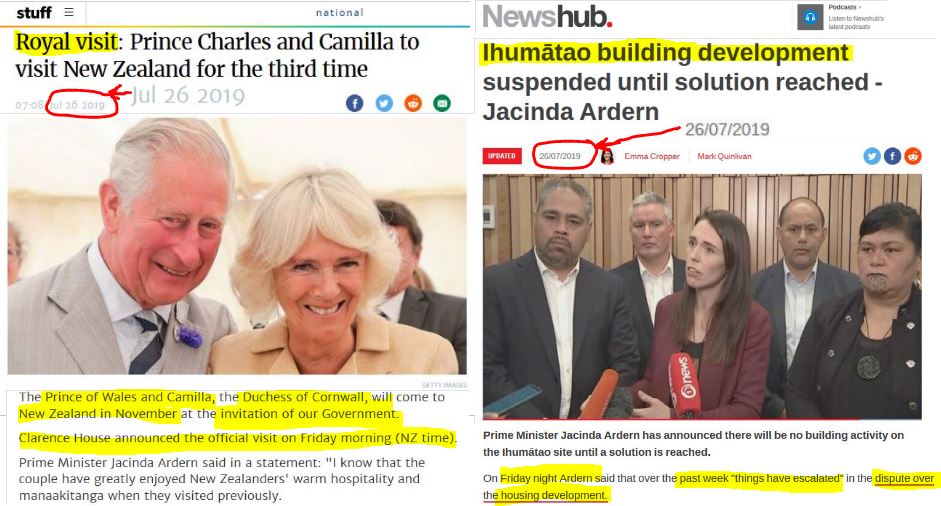
On the evening of Friday 26th July, Ardern announced a halt to construction, supposedly to allow time for a resolution to be found amid a groundswell of public support for the occupation just three days after 150 Police moved in to remove ten ‘squatters’.

Fascinating, Newshub revealed on November 28th 2019, that Jacinda Ardern’s own staff at the Minister of Arts, Culture and Heritage had advised her on January 26th 2018 to go to Ihumātao and had drafted a letter stating she would wait until after an Environment Court Decision (of 7 November 2018).
By her own recklessly ignorant deeds, words and inactions, the Minister for Culture and Heritage and Prime Minister opted to stonewall the Protect Ihumātao campaign group, SOUL. As PM, Ardern sought to control the crisis rituals, including short-circuiting the groundswell support, by claiming to facilitate resolution processes, whilst conspicuously avoiding going to Ihumātao (to keep the mana of Māori in its present diminished place relative to the Neo-Feudal Crown of Her Majesty’s Realm)
The Queen Victoria Connection
The 2.6m-long korowai, or a cloak woven from fine flax fibres, had been gifted to Queen Victoria by Ngāpuhi chief Reihana Takauwau on a visit to the Patronness of English Freemasonry’s summer residence, Osborne House, on the Isle of Wight, on 15 July 1863. Chief Takauwau was travelling as a part of a 13-member theatre company set up by Wesleyan lay preacher, William Jenkins, whose business venture was to demonstrate to Māori the power and resources of Britain, with Governor Grey’s approval − and evidently its class system. The Wesleyan travelled first class on the Ida Ziegler, while his guests were given worm-infested biscuits which they rightly threw overboard and were instead fed by British soldiers.
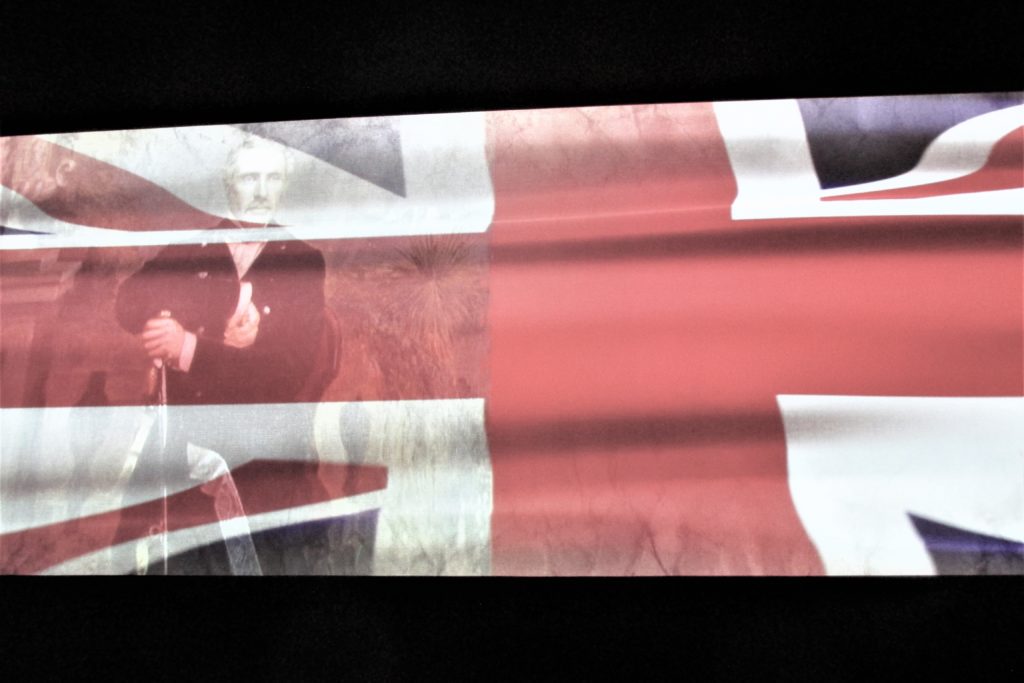
Ironically, before this 13-member theatre company had reached England, Queen Victoria’s son, HRH Prince George William Frederick Charles, who was the Commander-in-Chief of British Armed Forces, signed orders on April 13th 1863 for the 43rd, the 50th and 68th Regiments to travel to New Zealand in accordance with the war plans of Freemason Governor Bro. George Grey. Also ironically, another Wesleyan lay-preacher, Thomas Russell, who as the primary founder of the Bank of New Zealand played a pivotal role in brokering a £3 million war loan for the Colonial Government, also facilitated a rolling overdraft to meet military expenses and distributed war resources as Colonial Defence Minister.
Emotional Hijacking: Queen Elizabeth II loan heirloom to Waitangi Museum
It would appear then, that the Prince of Wales’s charm offensive contained carefully codified communications designed primarily for an élite audience attuned to the language of metaphor, Discovery Doctrine rituals and crisis rituals to retake control of national narratives, myths and ceremonies.
The presentation of the 2.6m-long korowai in a ‘wrapped-up’ state to the descendants of Ngāpuhi chief Reihana Takauwau’s siblings inside Te Whare Rūnanga, appeared to signal the Monarchy was endorsing the loan of Tax-Herd monies to fund a buy-back of lands at Ihumātao.
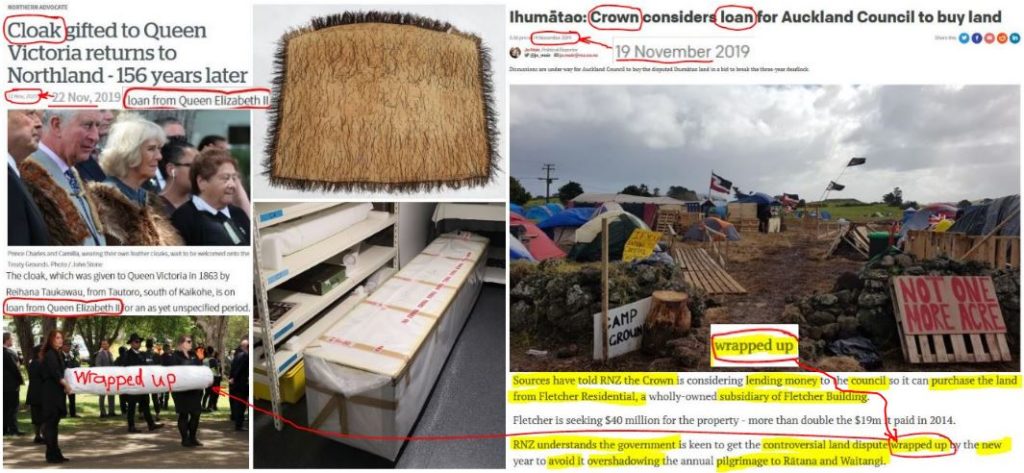
The phenomenon of the news breaking story that the Crown was considering a loan to Auckland Council to buy-back land at Ihumātao confiscated in July 1863, the day before Prince Charles ceremonially presented the ‘wrapped-up’ korowai gifted to Queen Victoria on July 15th 1863 for loan to Te Kōngahu Museum of Waitangi – is consistent with game theory.

Given that on the morning of July 26th 2019, the London Residency of the Duke and Duchess of Cornwall, Clarence House, announced that the Royal Family couple had accepted the NZ Government’s invitation to visit New Zealand in November, and that later the same day, in the evening, NZ PM Jacinda Ardern announced a halt to the planned residential construction on the disputed land at Ihumātao – this double ‘coincidence’ is uncanny.
It appears that the New Zealand Government was advancing the Neo-Feudal Crown Monopoly Game to control the Ihumātao crisis narrative arc, by controlling the crisis rituals in order to fix the preferred crisis solutions that maintains the Sole Sovereign Status of the Royal Monarchy.
Moreover, the ‘coincidence’ of the Prince meeting with Jacinda Ardern and the leader of the National Party, Simon Bridges on November 19, as well as the Governor-General at Government House in Auckland, on the same day as RNZ broadcast the leak about the Crown loan for Ihumātao makes those ‘coincidences’ more intriguing. Especially, since the government was evidently “keen to get the controversial land dispute wrapped up by the new year to avoid it overshadowing the annual pilgrimage to Rātana and Waitangi.” This motive when combined with the timing, suggests that private talks were held about the importance of stabilizing the situation to maintain the Pākehā-dominated Ruling Class’s position to keep control of the Neo-Feudal Realm.
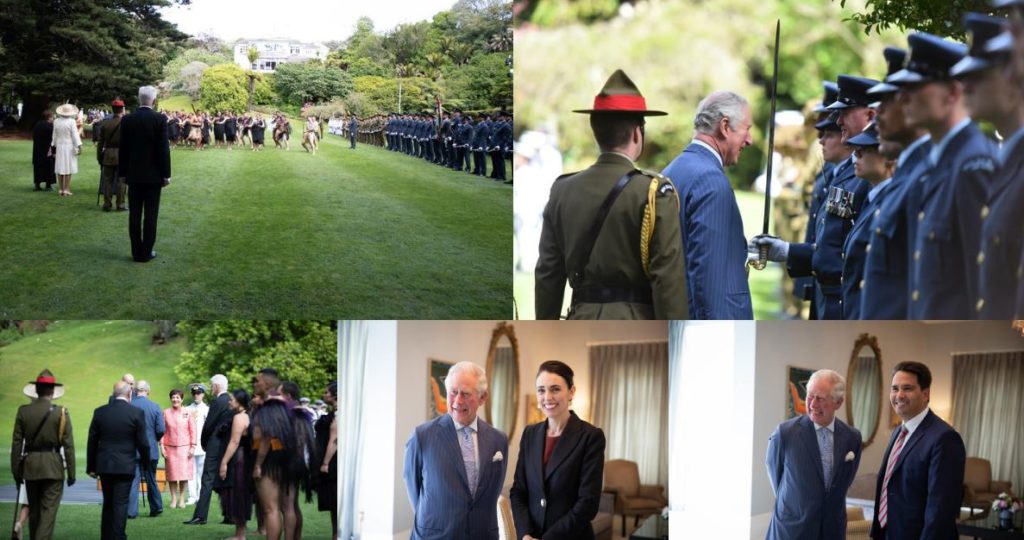
Therefore, the ‘coincidence’ of a korowai that was gifted by a Ngāpuhi chief to Queen Victoria on July 15 1863, and now being loaned to the Waitangi Museum while the Crown considers a loan for a buyback of land at Ihumātao is completely consistent with game theory.
Ironically, Queen Victoria was given this korowai by Ngāpuhi Rangatira Takauwau, who evidently spoke about land-loss and the Treaty breaches. While concurrently, the Governor of the New Zealand Colony and Commander-in-Chief, who was also a Knight Commander in the Companion Order of the Bath – Freemason Governor Bro. George Grey – was overseeing the start of the Waikato War of 1863-64. Governor Bro. Grey had just evicted ‘the Natives’ of Ihumātao by Proclamation, dated July 9th 1863, on the fiction that they were in rebellion, when in fact, they were alligned with the Kiingitanga, which was formed with a mandate to stop any more land sales.
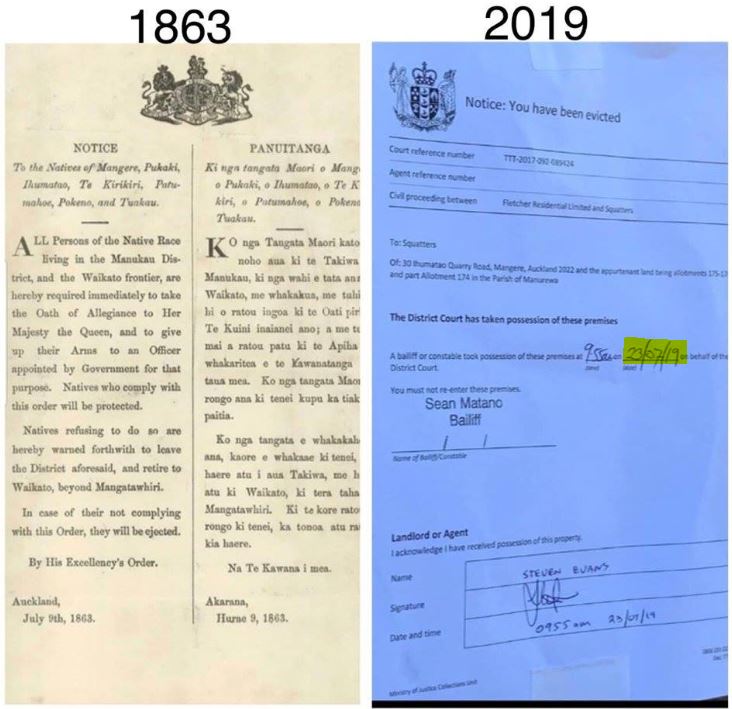
Furthermore, when it is recalled that the Prince announced on July 26th that he had accepted the NZ Government’s invitation to visit New Zealand in November – and that date was the same day that NZ PM Jacinda Ardern announced a halt to construction at Ihumātao, the élite-élite communications to stabilize the situation are detectable. It appears the Crown has sought to control the crisis rituals to avoid amplified discussion about how exactly and why exactly private land buybacks became a scared cow issue in New Zealand.
It turns out, land buybacks for Māori were short-circuited by a malicious act of arson on July 4th 1992, a crminal act that was not prosecuted until 2013. The arson of a farmer’s home was self-inflicted by a farmer Alan Titford. Because Titford blamed aNorthland iwi, Te Roroa – whom sought the return of urupa, burial caves and other wāhi tapu sites on farmed lands at the Maunganui Bluff, Aranga, north-west of Dargaville – and because National MP Ross Meurant rang The New Zealand Herald, New Zealand’s cultural-wide racism held sway to green-light more institutionally racist, structural stonewalling – as The Snoopman showed in “Fraught Precedents for Land Buy-Backs”.

The racist furore stirred up by Titford and his farming supporters resulted in the Bolger-National Government barring the Waitangi Tribunal from recommending such sacrilegious property transfers and thereby making discourse about private-land buy-backs a heretical act in the racist Neo-Feudal Realm of New Zealand.
Royal Charm Offensive Spells to Prolong the Neo-Feudal Realm
It is particularly galling that this racist white supremacist status persists given that the Neo-Feudal Prince performed or participated in ceremonial rituals during his November 2019 visit to New Zealand that were designed to reaffirm the sovereignty of Queen Elizabeth II and Her over-priviledged Heirs.

The deployment of Royal Charm Offensive Spells, particularly at Waitangi, were designed to lower expectations, construct acceptance to complete the treaty settlements and win loyalty to Royalty – as like Neo-Feudal British subjects – through emotional hijacking.
The potent symbolism of the Duke and Duchess of Cornwall at Waitangi was more loaded than most realised. Especially, when it is remembered that the 1834 National Flag of Shipping actually flies on the flag-staff at Waitangi, and bears the Cross of St George.
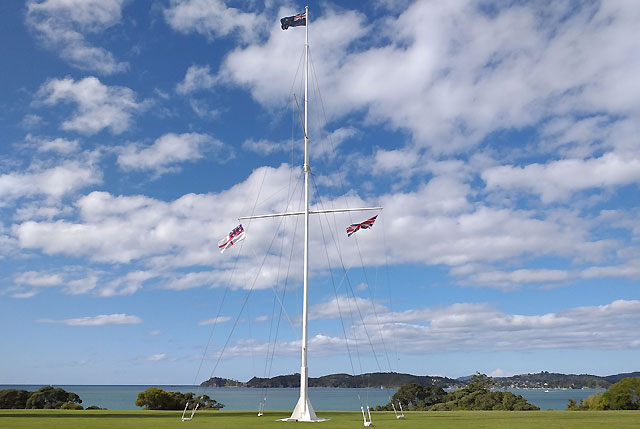
On March 20th 1834, New Zealand’s first British official, James Busby, lured his chosen rangatira aboard the HMS Alligator, to select a national flag for shipping. The chiefs, whom came wearing ceremonial cloaks for the occasion, had to prostrate themselves to get under a roped-off section inside a makeshift ‘tent’ made of sails on the deck. Curiously, the flag the chiefs ‘chose’ – by no means unanimous and by a thin slither – just happened to be the one with the St George’s Cross, a motif that appears everywhere in English heraldry and is the symbol of England’s national flag.
Busby’s machinations, in effect, laid a Treaty Theatre Track that complimented the work of the mostly Protestant missionaries to condition Māori to sign pieces of paper – as The Snoopman in his investigation, Royal Landlord Possession Rituals. He shows that a parallel Colonial Law Track was laid in 1839 and 1840, and that the Treaty Theatre Track served to defuse Māori resistance by tricking the chiefs (and the 13 wahine who signed) into believing they would retain their sovereign powers to exercise mana, rangatiratanga and other Māori customary law practices. Because even the findings of Ngāpuhi’s own tribal investigation, Ngāpuhi Speaks, as well as the Ministry of Justice’s Waitangi Tribunal report of 2014 – both missed this two-track stratagem – the vast majority of Māori, and empathetic Pākehā, do not realize the epic, layered brazenness of the swindle. In essence, a Waitangi Treaty Cliqué was performing theatre as they stealthily participated in the British takeover of New Zealand, that occurred prior to, during and after the Treaty signings, by mechanisms such as letters patent charters, proclamations and legislation that were consistent with English Constitutional Law.

Given that the Cross St George came to be on the 1834 National Flag of Shipping though Busby’s machinations, it is important to know about the Cross of St George and its use in the Order of the Garter and beyond. In 1348, King Edward the Third founded the English Order of the Garter, which is England’s most prestigious order, and features St George and the Dragon. Not surprisingly, given England’s fetish for the Cult of St George, this legendary character is the patron of all knighthoods, according to Orders and Decorations, written by Václav Měřička.
The symbolism of the Cross of St George is potent because The Duke of Cornwall’s private estate, The Duchy of Cornwall — which is approximately 54,845 hectares, or 135,526 acres, spread across 23 counties of England and Wales and includes over 600 residential lettings, commercial properties, a prison, and more than 700 agricultural tenancies, — was founded in 1337 by the same King Edward III who founded the Order of the Garter in 1348.
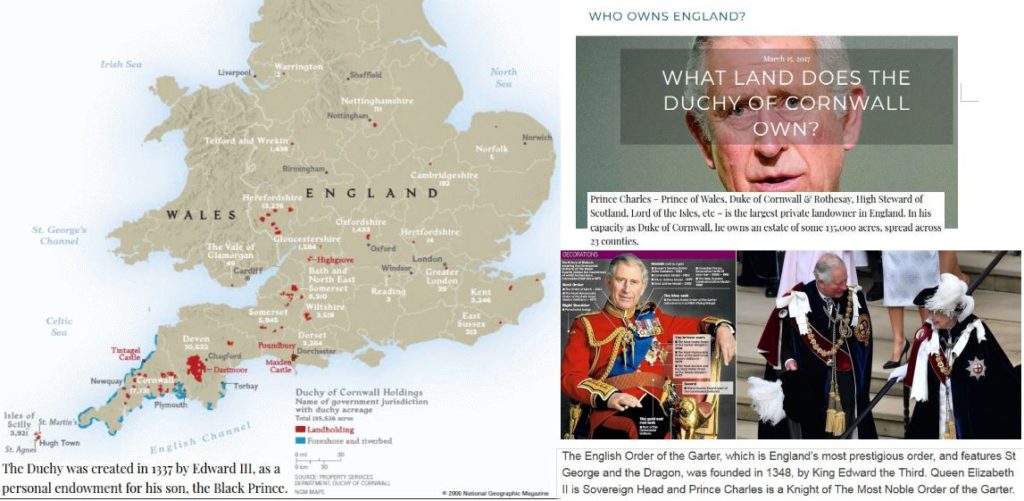
Queen Elizabeth II is Sovereign Head and Prince Charles is a Knight of The Most Noble Order of the Garter. As can be seen from the photos below, the red Cross of St George is featured on the medallions pinned to Prince Charles’s red coat and black robe, as well on the black robe worn by Queen Elizabeth II.
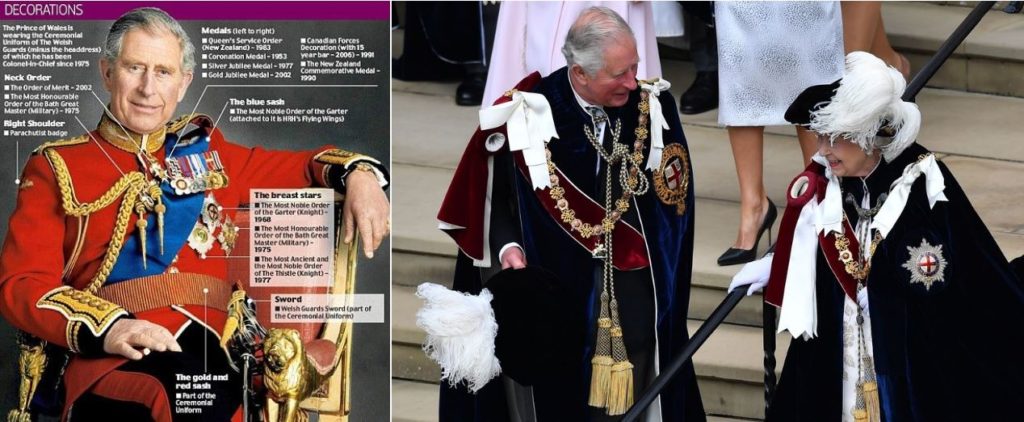
In other words, this Neo-Feudal billionaire’s estate of 212 square miles, was founded by the same King who started the oldest order in England, which was then used by Queen’s Victoria’s evilest son, King Edward VII, to draw the royalty of Spain, Portugal, Russia, Italy, Sweden, Persia and Japan closer by investing them as ‘stranger’ Garter Knights. In this way, King Edward VII used the Order of the Garter as one secret mechanism of a British ‘Secret Elite’ who pursued a diabolical conspiracy to embroil Europe in war, to lure Germany into smashing the Russian Empire to retard its development and as a means to forge a universal British Empire – as historians Gerry Docherty and Jim Macgregor reveal in Hidden History: The Secret Origins of the First World War.
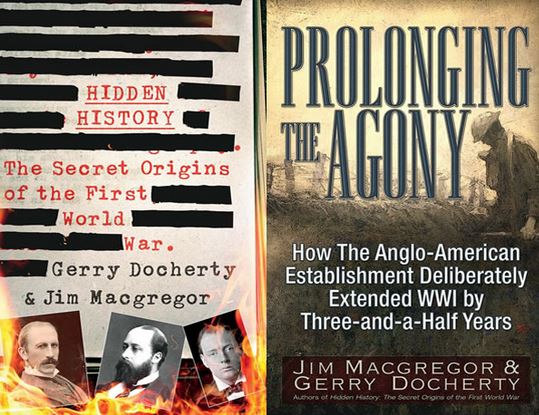

Conspicuously, The Duke and Duchess of Cornwall’s schedule was ‘unbooked’ for the day after they were at Waitangi.
Therefore, the timing of the korowai loan from Queen Elizabeth II on November 20th 2019 takes on an epic symbolic potency.
The high stakes in the land dispute at Ihumātao suggests the Heir Apparent to the British Throne was meeting with those that comprise the New Zealand Crown – given the detectable symbolism used to communicate in a codified way to the Pakeha-dominated Ruling Class whom are attuned to such encoded signals. Because, if matters were to snowball into a widespread shift in the political ground around the Crown, whereby a sustained groundswell supporting private land being vested to hapū and iwi with Māori sovereign title — then the Crown could quickly undergo a catastrophic collapse in its power.
It would, therefore, not be surprising to find out that such a possible, nebulous Crown meet-up included something like the ‘Twenty Ruling Families’.
To sum up, the Royal visit to New Zealand by the neo-feudal billionaire and Knight of the Order of the Garter, The Prince of Wales, and his wife, The Duchess of Cornwall, was a charm offensive, crisis intervention, and legal exercise to maintain the hereditary rights of the British Monarchy over the Realm of New Zealand — wrested by swindle, stealth and struggle.
It was as much about pulling the Waitangi host iwi, Ngāpuhi, into the Crown’s orbit to settle, cede, and submit — as it was about ensuring that land buy-backs for Māori don’t become an election issue. The control of both of these narratives is critical for the Neo-Feudal Crown, because their political kryptonite weakness is close exposure to the Myth of Cession by treaty.
Editor’s Note: Please let Steve Edwards, know if we have made any errors, with your counter-evidence.
e: steveedwards555@gmail.com
This in-depth analysis: Royal Landlord Possession Rituals explores what The Snoopman believes underpinned Prince Charles’s recent visit. The ‘nose section’ gives an overview; the ‘cockpit section’ covers neo-feudal billionaire’s possession and occupation rituals as they relate to the Discovery Doctrine (mostly at Waitangi); the ‘first class section’ analyses Crafty Charlie’s Waitangi speech including the coincidence of QEII’s korowai loan & the Crown’s possible loan for Ihumaatao; the ‘cattle class section’ explores the two parallel tracks – a Colonial Law Track and a Treaty Theatre Track – that were laid during the British takeover of New Zealand; and the ‘tail section’, ‘Trick or Treats – The Enduring Cession Myth’ – wraps up the missing context revealed, the issues and signposts possible radical solutions to change the political ground around the Crown.
